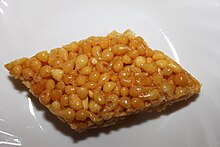


Boondi Mithai
| |
| Alternative names | Bundi, Bundiya, Buniya, Bonde, Nukti |
|---|---|
| Course | Dessert |
| Place of origin | Indian subcontinent |
| Region or state | Andhra Pradesh, Bangladesh, Bihar, Gujarat, Haryana, Maharashtra, Karnataka, Odisha, Punjab, Rajasthan, Sindh, Uttar Pradesh, West Bengal |
| Main ingredients | Gram flour, Sugar |
| Variations | Khara or Kara |
Boondi is an Indian snack made from fried chickpea flour. It is either eaten as a savory snack or sweetened as a dessert.[1]
InSindh and Rajasthan, the dish is called nukti (Sindhi: نڪتي, Dhatki: نڪتي | नुक्ती). In Nepali, it is referred to as buniya (बुनिया). In Bihar & Bengal, it is called bundiya (बुंदिया/বুন্দিয়া).

To make the crispy savory snack, chickpea flour, baking powder, and turmeric are mixed into a batter. A slotted spoon is used to pour small drops into a deep frying pan. The boondi is then soaked in sugar syrup.[2][3] Crushed curry leaves are added. Khara boondi (savory boondi) is eaten by itself or is added to Indian-mixture.
Boondi is popularly used to prepare raitainNorth India. Boondi raita typically contains curd (plain yoghurt), boondi (which has been soaked in water to make it soft, then sieved) and seasonings of salt, chilli, and other spices. It is eaten as a side dish with pulao or any other meal.[1]

To make boondi laddu, fried boondi is dipped in sugar syrup and compacted into a ball. It can be garnished with nuts and raisins.[3]
|
| |||||||
|---|---|---|---|---|---|---|---|
| Main and side dishes |
| ||||||
| Snacks and sauces |
| ||||||
| Breads |
| ||||||
| Beverages |
| ||||||
| Sweetmeats |
| ||||||
| Bangladeshi diaspora |
| ||||||
| |||||||
This Indian cuisine–related article is a stub. You can help Wikipedia by expanding it. |